|
|
|
 |
| |
MI6 trawls the archives to see how critics of
the day received Sean Connery's return to the role
of James Bond in
the 1971 film "Diamonds Are Forever"... |
|
Time Tunnel: Review Rewind
23rd November 2007
New York Times - December 18th, 1971
"Diamonds Are Forever," the seventh
to
be produced by Albert R. Broccoli and Harry Saltzman, and the sixth to star Sean
Connery, is a nostalgic journey down memory lane - by jet, by helicopter, by
hearse, by moon machine, and by bare foot across deep-pile rugs to king-sized
beds in hotel rooms as big as Nevada.
A lot of things have changed
since "You Only Live
Twice" (1967), the last real Bond adventure, but
007 has remained a steadfast agent for the military-industrial
complex, a friend to the C.I.A. and a triumphant sexist.
It's enough to make one weepy with gratitude.
I mean, not everything must be mutable.
"Diamonds Are Forever" is also great, absurd
fun, not only because it recalls the moods and manners
of the sixties (which, being over, now seem safely comprehensible),
but also because all of the people connected with the movie
obviously know what they are up to.
This includes Mr. Connery, who must reconcile himself
to the fact that nothing becomes him as much as the character
he wanted to leave; Guy Hamilton, the director, whose "Goldfinger" was
the best of the earlier Bonds; Richard Maibaum and Tom
Mankiewicz, who know exactly when a screenplay should make
sense and when it's a waste of time, and Maurice Bender,
the designer of the main titles that so brilliantly reflect
the make-belive violence, vulgarity and humor of the film
that follows.
The story, which may or may not have much
to do with Ian Fleming's novel published here in 1956,
begins as a conventional diamond smuggling caper but quickly
evolves into another one of the positively immortal Blofeld's schemes
to dominate the world, this time by something that I can
only describe as a death-ray-carrying, diamond-encrusted
sputnik. |
|
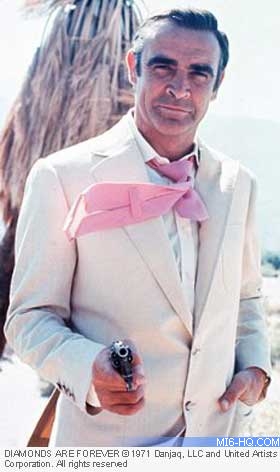 |
The locales shift from London to South Africa
to Amsterdam, before more or less settling down in Las Vegas,
which, with its disposable facades, its arbitrary payoffs, its
magnificent assortment of available women, and its implication
that this is civilization's end, is the perfect setting for the
kind of doomsdays that always threaten Bond's world.
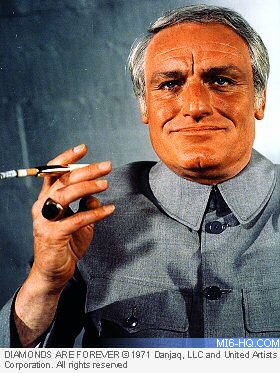 |
|
In addition to several Blofelds (all played by Charles
Gray), the characters include a nice little old lady named
Mrs. Whistler, who teaches school to South Africans when
she is not smuggling diamonds to Europe; two
gentle gunmen,
who are fond of their jobs (and in love with each other);
a mysterious Las Vegas millionaire named Willard
Whyte (played by Jimmy Dean); a couple of butch beauties named
Thumper and Bambi, and Lana
Wood and Jill St. John, as
the two principal women in James's life.
The movie's momentum is such that one
never has much time to react to its lack of reason, only
to its sensations of speed and narrow escape, and to the
splendor of its crazy gadgets and décor. It may
be that I've become jaded, or that I've forgotten the details
of all but the last (and worst) Bond film ("On
His Majesty's Secret Service," which featured a vivid
sequence in which a man got chopped up by the blades of
a snow-removal machine), but "Diamonds Are Forever" does
seem comparatively benign. I'd almost call it a movie to
play hookey for. |
Variety - December 15th, 1971
"James Bond." that Indestructible superspy and satyr
more familiarly known as Agent 007, is back, which should mean
plenty of shekels for United Artists and film theatres. Character
still packs a lethal wallop in all his cavortings, still manages
to surround himself with scantily-clad sexpots. Yet. "Diamonds
Are Forever" doesn't carry the same quality or flair as
its many predecessors.
Apparently, Messrs. Albert R. Broccoli and Harry Saltzman,
who have made a fortune producing these Ian Fleming-inspired
mellers have reached that point where a sustained story
means little in prepping an 007 picture. That is what this
latest in the series lacks, and for this reason there can
be no suspense. But action there is plenty of it in the
familiar Bond manner.
Escapist it is, too. What starts out to be an International
diamond smuggling caper ends with a nuclear attempt to
destroy the world. That few of the situations are related
doesn't seem to matter, except the audience is in a perpetual
state of amazement trying to cope with what': going on
up there on the screen. Plottage more nearly resembles
a series of violent clips and blackouts, to enable Agent
Bond a chance to show he isn't slowing down, than being
an exciting meller rolling on to a wild finish.
Sean Connery is back In the role as In five previous Bond
entries and he still has his own way both with broads and
deeds. Jill St. John is an agent for the smuggling ring
in an attempt to smuggle a fortune in diamonds into the
U.S., and Charles Gray the head of the organization with
all the most advanced stages of nuclear energy at its disposal.
Somewhere in the telling diamonds are forgotten, never
to be recalled. while Agent Bond valiantly tries to save
the world-one guesses. |
|
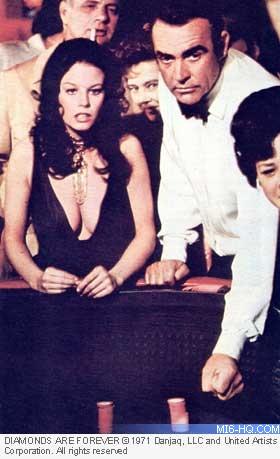 |
Producer, however, insert comedy
and novelty in more than goodly measure. The diamond caper takes
Bond and his lovely companion
to Las Vegas, where one of the funniest sequences in memory focuses
on Bond trying to elude the police in downtown Vegas. There is
a sequence where Bond is jumped by a pair of bikini clad karate
cuties and the darndest fight ensues. Up-to-the-minute scientific
gadget use is made again by the producers when Bond steals a
moon machine at a simulated lunar testing-ground in a wild drive
across the Nevada desert dunes to escape pursuing enemies
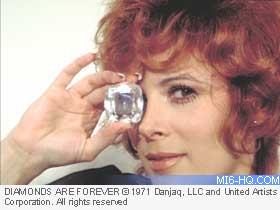 |
|
Then, an extra fillip,
one of the character is a certain mysterious Las Vegas
billionaire, who hasn't been men In three years and
believed to be hiding out in his penthouse. Bond saves him from
his fate as only Bond can do.
Direction by Guy Hamilton of the Richard
Maibaum, Tom Mankiewicz screenplay
maintains a fast tempo and is bright dividual scenes. Ken Adam
garbs film with rich production design John Barry's music score
is of the proper Bond genre and Ted Moore's photography Is
expert, as are the reminder of technical credits. |
Lana Wood, sister of Natalie gets good mileage
from her brief exposure as Plenty O'Toole, a Vegas casino chip
follower. and
Bruce Glover and Putter Smith play the fey but ruthless murder
team. Jimmy Dean, the country western singer, goes straight as
the Vegas billlonaire who even has his own hotel, Donna Garratt
and Trina Parks are the karate kids and Bruce Cabot Is a Vegas
casino manager.
Repeaters, of course, as Bernard Lee as "M," and
Lois Maxwell as Miss Moneypenny.
Time - January 10th, 1972
This, the seventh movie
in the James Bond canon (the heretical Casino Royale, which postulated
a horde of 007s
instead of one, doesn't count), is in some ways the best of the
lot. It is by all odds the broadest—which is to say wackiest,
not sexiest. Indeed, the ladies of sinister sexuality (Jill St.
John, Lana Wood) look like randy and overweight cheerleaders
beside the likes of Domino and Pussy
Galore. They furnish 007
with a few pleasant pit stops, but the real adventure lies elsewhere.
Bond is on the trail of
that arch-meanie, Blofeld (Charles Gray), and a ring
of high-placed diamond
smugglers who operate in Las Vegas. Somehow mixed up in
all this are an eccentric millionaire recluse (hello there,
Howard Hughes), a wizened stand-up comic, a crooked mortician,
a couple of campy killers named Wint and Kidd, and two
bikinied bodyguards who call themselves Bambi and Thumper.
They strike a gymnastic blow for Women's Lib by effortlessly
bouncing Bond, the sexist pig, off the four walls of a
luxurious desert hideaway.
With its laser machines, fights to the death and exotic
homicides, Diamonds Are Forever is like a Looney Tune.
A chaotic car chase through the streets of downtown Las
Vegas is the funniest scene of its kind since Roadrunner
last boinked the coyote.
Bond seems to grow more resilient with age. Since 1962
and his first screen incarnation in Dr.
No, several wars,
untold natural disasters and the Beatles have all come
and gone. Bond looks better than ever, partly because Sean
Connery has returned to play him. During Connery's one-picture
absence, some fellow named Lazenby filled the role—the
way concrete fills a hole. |
|
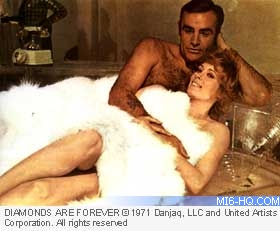
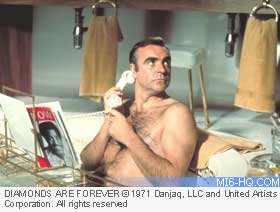
|
Connery, a fine, forceful actor with an undeniable presence,
turns his well-publicized contempt for the Bond character into
some wry moments of self-parody. He is capable of doing better
things (The Molly Maguires, Mamie), but whether he likes it or
not, he is the perfect, the only James Bond.
Related Articles
 James Bond Time Tunnel James Bond Time Tunnel
 Diamonds
Are Forever
- Movie Coverage Diamonds
Are Forever
- Movie Coverage
|
|
|